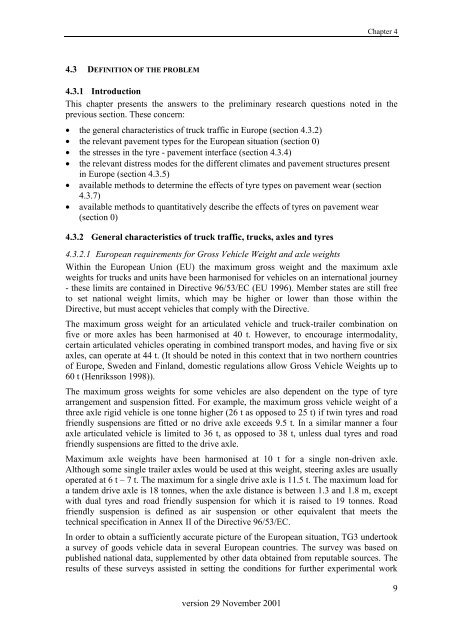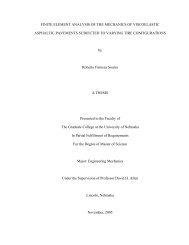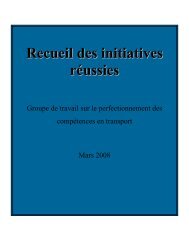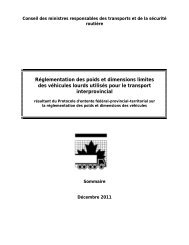You also want an ePaper? Increase the reach of your titles
YUMPU automatically turns print PDFs into web optimized ePapers that Google loves.
Chapter 44.3 DEFINITION OF THE PROBLEM4.3.1 IntroductionThis chapter presents the answers to the preliminary research questions noted in theprevious section. These concern:• the general characteristics of truck traffic in Europe (section 4.3.2)• the relevant pavement types for the European situation (section 0)• the stresses in the tyre - pavement interface (section 4.3.4)• the relevant distress modes for the different climates and pavement structures presentin Europe (section 4.3.5)• available methods to determine the effects of tyre types on pavement wear (section4.3.7)• available methods to quantitatively describe the effects of tyres on pavement wear(section 0)4.3.2 General characteristics of truck traffic, trucks, axles and tyres4.3.2.1 European requirements for Gross Vehicle Weight and axle weightsWithin the European Union (EU) the maximum gross weight and the maximum axleweights for trucks and units have been harmonised for vehicles on an international journey- these limits are contained in Directive 96/53/EC (EU 1996). Member states are still freeto set national weight limits, which may be higher or lower than those within theDirective, but must accept vehicles that comply with the Directive.The maximum gross weight for an articulated vehicle and truck-trailer combination onfive or more axles has been harmonised at 40 t. However, to encourage intermodality,certain articulated vehicles operating in combined transport modes, and having five or sixaxles, can operate at 44 t. (It should be noted in this context that in two northern countriesof Europe, Sweden and Finland, domestic regulations allow Gross Vehicle Weights up to60 t (Henriksson 1998)).The maximum gross weights for some vehicles are also dependent on the type of tyrearrangement and suspension fitted. For example, the maximum gross vehicle weight of athree axle rigid vehicle is one tonne higher (26 t as opposed to 25 t) if twin tyres and roadfriendly suspensions are fitted or no drive axle exceeds 9.5 t. In a similar manner a fouraxle articulated vehicle is limited to 36 t, as opposed to 38 t, unless dual tyres and roadfriendly suspensions are fitted to the drive axle.Maximum axle weights have been harmonised at 10 t for a single non-driven axle.Although some single trailer axles would be used at this weight, steering axles are usuallyoperated at 6 t – 7 t. The maximum for a single drive axle is 11.5 t. The maximum load fora tandem drive axle is 18 tonnes, when the axle distance is between 1.3 and 1.8 m, exceptwith dual tyres and road friendly suspension for which it is raised to 19 tonnes. Roadfriendly suspension is defined as air suspension or other equivalent that meets thetechnical specification in Annex II of the Directive 96/53/EC.In order to obtain a sufficiently accurate picture of the European situation, TG3 undertooka survey of goods vehicle data in several European countries. The survey was based onpublished national data, supplemented by other data obtained from reputable sources. Theresults of these surveys assisted in setting the conditions for further experimental workversion 29 November 20019






